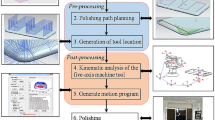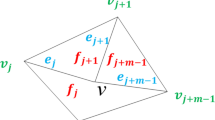Abstract
Most of the automobile panels are surface. Considering the limitation of machining the surface with the ball-end cutter, the non-spherical cutter is used more and more widely, but the interference usually occurs when machining the surface. Therefore, in this paper, the overcut interference produced by the annular cutter in machining convex surface of automobile panels was studied. The interference was analyzed, the method of eliminating interference was determined. The position of interference points was determined by the experiments of convex surface. The cutter orientation tool was optimal, and then re-planned the tool path with the method of interpolation to eliminate the interference. For convex surface, the traditional method and optimized one were compared, and the feasibility of the optimization method was verified.



























Similar content being viewed by others
References
Hauth, S., Richterich, C., Glasmacher, L., et al.: Constant cusp tool path generation in configuration space based on offset curves. Int. J. Adv. Manuf. Technol. 53(1–4), 325–338 (2011)
Lee, S.G., Kim, H.C., Yang, M.Y.: Mesh-based tool path generation for constant scallop-height machining. Int. J. Adv. Manuf. Technol. 37(1–2), 15–22 (2008)
Xiaobing, C., Wenhe, L., Haibing., W.: An algorithm for constant scallop-height tool path generation for triangular mesh surface machining. J. Comput. Aided Des. Comput. Graph. 21(12), 1800–1804 (2009)
Peiqing, Y., Tao, C., Jinsong, W.: Tool path planning algorithm for five-axis NC machining of sculptured surfaces. Mech. Sci. Technol. 23(08), 883–886 (2004)
Fuzhong, W.: Constant scallop-height tool path planning by constructing envelope surface. J. Agric. Mach. 40(1), 217–221 (2009)
Ding, S., Mannan, M.A., Poo, A.N., et al.: Adaptive iso-planar tool path generation for the machining of free-form surfaces. Comput. Aided Des. 35(2), 141–153 (2003)
Ding, S., Mannan, M.A., Poo, A.N., et al.: The implementation of adaptive isoplanar tool path generation for the machining of free-form surfaces. Int. J. Adv. Manuf. Technol. 26(7–8), 852–860 (2005)
Liang, W.C., Zhang, P., He, M.: Tool path planning of NURBUS surface based on STEP-NC. Mech. Res. Appl. 26(3), 178–183 (2013)
Taiyong, W., Zhiqiang, Z., Tao, W.: High precision tool path planning algorithm for complex parametric surface. J. Mech. Eng. 43(12), 109–113 (2007)
Li, F., Wang, X.C., Ghosh, S.K., Kong, D.Z.: Gouge detection and tool position modification for five-axis NC machining of sculptured surfaces. J. Mater. Process. Technol. 48(1–4), 739–745 (1995)
Warkentin, A., Bedi, S., Ismail, F.: 5-axis milling of spherical surfaces. Int. J. Mach. Tools Manuf 36(2), 229–243 (1995)
Gray, P., Bedi, S., Ismail, F.: Rolling ball method for 5-axis surface machining. Comput. Aided Des. 35(4), 347–357 (2003)
Gray, P., Ismail, F., Bedi, S.: Graphics-assisted rolling ball method for 5-axis surface machining. Comput. Aided Des. 36(7), 653–663 (2004)
Man, J., Li, Z., tong, C.Z.: End-points error controlling method for torus tool position optimization in five-axis NC machining. J. Beijing Univ. Aeronaut. Astronaut. 32(9), 1125–1128 (2006)
Ruiqiu, W., Man, J., Wuyi, C.: Improvement of end-point error controlling tool path generation method. J. Aeronaut 28(2), 438–444 (2007)
Choi, B.K., Jun, C.S.: Ball-end cutter interference avoidance in nc machining of sculptured surface. CAD 21(6), 371–378 (1989)
Hwang, J.S.: Interference-free tool path generation in the NC machining of parametric compound surface. CAD 24(12), 667–675 (1992)
Hansen, A., Arbab, F.: Fixed axis tool positioning with bulit-in global interference checking for NC path generation. IEEE J. Robot. Autom. 4(6), 610–621 (1988)
Takeuchi, Y., Idemura, T.: 5-axis control machining and grinding based on solid model. Ann. CIRP 40(1), 455–458 (1991)
Chen, Y., Wang, Y.: Isoscallop of self-adaptive tool orientation with toroidal cutter under optimum orientation of MCPs. In: 2012 IEEE International Conference on Materials Engineering and Automatic Control, ICMEAC, pp. 713–716 (2012)
MNFREDOPC.Differential geometry of curves and surfaces. China Machine Press, Beijing (2004)
Author information
Authors and Affiliations
Corresponding author
Rights and permissions
About this article
Cite this article
He, C., Zheng, M., Yang, S. et al. Tool path planning without interference for convex surfaces based on the optimal cutter orientation of the annular cutter. Int J Interact Des Manuf 12, 787–800 (2018). https://doi.org/10.1007/s12008-017-0424-x
Received:
Accepted:
Published:
Issue Date:
DOI: https://doi.org/10.1007/s12008-017-0424-x




